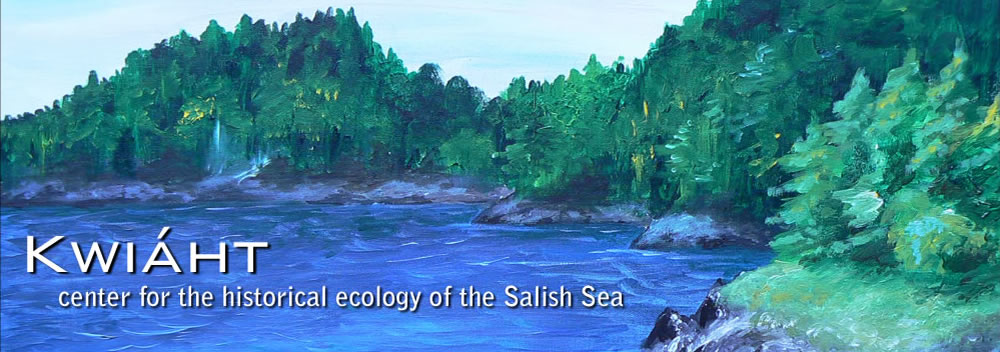The following essay originally appeared in the Islands Weekly (Lopez) © 2008 Reproduced by permission
Ancient agriculture
Farming has been a way of life in the San Juan Islands for a long time: perhaps as long as 2,500 years! Like peasant communities in Europe, native Coast Salish peoples of the islands not only fished, but also raised crops and livestock. Early European explorers observed cultivated fields and flocks of “woolly dogs,” but by the late 19th century, when serious study of Coast Salish languages and cultures began, native peoples had lost most of their land, and exchanged their traditional crops and dogs for potatoes and sheep.
Camas (Camassia leichtlinii and Camassia quamash), a member of the Liliaceae or Lily family, was the staple of Coast Salish agriculture. Spring hoeing encourages this plant to reproduce asexually: its bulbs split and form clusters like shallots. Camas fields were weeded aggressively to remove competing grasses and poisonous bulbs of “death camas” (Zigadenus venenosus); and were burned every few years to suppress shrubs and recycle nutrients—light burns do not damage the deeply buried camas bulbs.
Like Jersualem artichokes, camas bulbs store energy as inulin, a polysaccharide that breaks down into fructose (“fruit sugar”) when sufficiently cooked, traditionally for a couple of days in a pit with heated rocks and wet packing. Mildly sweet, cooked camas can be enjoyed at once, or dried into cakes and used later.
Coast Salish peoples grew camas in wetlands, on small islets, and on soft bluffs overlooking the sea. (Settlers also targeted wetlands, and the rich soils formed by years of camas cultivation, for farming here, so most of the evidence of camas in our wetlands has been lost.) Camas gardens were located near good summer salmon fishing sites, so that fishing and farming activities could be carried out simultaneously. Deer were probably also hunted when they tried to browse in camas fields: venison for a camas-sweetened stew!
Other Liliaceae were grown, including Columbia lilies, Chocolate lilies and Rice- root. Burning promoted Harvest brodiaea bulbs, native onions, and Bracken ferns, which have starchy rhizomes. Nettles were cultivated for twine. Cinquefoil and Springbank clover may have been grown here in the islands as they were along the Strait of Georgia, in estuarine gardens behind dikes; these plants have fleshy rhizomes once eaten steamed.
Like gardeners everywhere, Coast Salish peoples were always eager to try new plants. Potatoes appear to have reached our area from Mexico by 1800, via Spanish trade with the Nuu-Chah-Nulth and Makah. (“Ozette” is a Makah heritage potato variety from this era.) British and American explorers saw potatoes growing in marked fields around Coast Salish villages in the 1820s, and by 1855, camas was a distant second to potatoes in Coast Salish gardens. Potatoes grow faster and yield more.
You can still see camas growing wild throughout the San Juan Islands on rocky outcrops and unplowed meadows from which sheep and deer have been excluded. Don’t look for an easy feast, however: most uncultivated camas produces bulbs the size of lima beans!
If you’re interested in growing and protecting native camas varieties here in the islands, join Kwiaht’s camas growers network! We also recommend reading Keeping It Living, edited by Douglas Duer and Nancy Turner.
